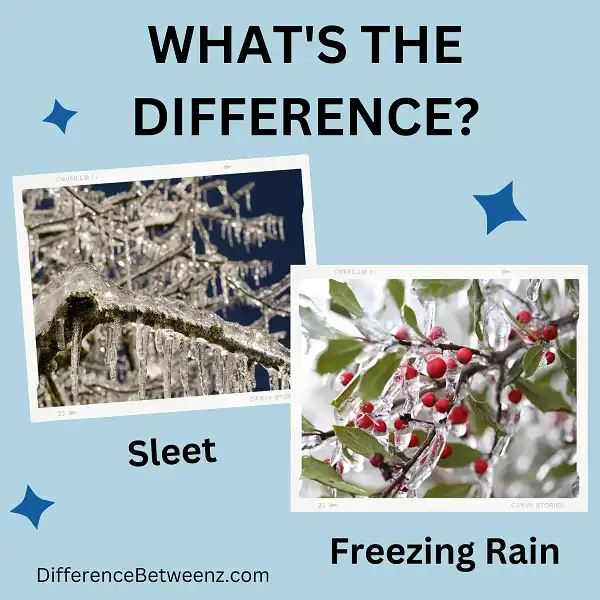What’s the difference between sleet and freezing rain? Most people use these terms interchangeably, but they are actually quite different. Sleet is a form of precipitation that is made up of ice pellets. Freezing rain, on the other hand, is precipitation that falls as a liquid and then turns to ice as it makes contact with the ground or objects. In most cases, freezing rain produces much more serious weather conditions than sleet. Let’s take a closer look at each one!
What is Sleet?
Sleet is a type of precipitation that is generally composed of small, frozen pellets of ice. Sleet typically falls from clouds that are layered, with warmer air near the ground and colder air above. When this warm air rises, it cools and condenses into cloud droplets.
- As these droplets fall, they pass through a layer of cold air and freeze into pellets of ice. Sleet can often be mistaken for rain, as it tends to fall in liquid form before freezing on impact. However, sleet is usually more transparent than raindrops and often has a higher density.
- While sleet can occur during any season, it is most common in winter and spring. Sleet often precedes or follows a period of snowfall, as it requires both snow and rain to form.
- In addition to being a nuisance for motorists and pedestrians, sleet can also cause power outages and tree damage. As a result, it is important to be aware of the threat that sleet poses during periods of inclement weather.
What is Freezing Rain?
Freezing rain is a type of precipitation that falls as liquid raindrops but freezes upon impact with the ground or other surfaces. It typically occurs when there is a layer of warm air above the ground, allowing the rain to fall as liquid, while a layer of colder air near the ground causes the raindrops to freeze upon impact.
Freezing rain can create a glaze of ice on trees, power lines, and roads, making travel extremely hazardous. In addition, freezing rain can cause power outages by weighing down power lines and tree branches. As a result, freezing rain is a serious weather hazard that can have significant impacts on people and infrastructure.
Difference between Sleet and Freezing Rain
Sleet and freezing rain are two types of winter precipitation that can cause problems for drivers and pedestrians.
- Sleet is made up of ice pellets that are smaller than hail. These pellets bounce when they hit the ground, making them dangerous for people and vehicles.
- Sleet can also accumulate on roads and sidewalks, making them slick and difficult to navigate.
- Freezing rain is made up of liquid raindrops that freeze when they come into contact with cold surfaces like pavement or power lines.
- This can create an icy glaze that is extremely slippery. In addition, freezing rain can cause tree limbs to break due to the added weight of the ice.
As a result, it is important to be aware of the difference between sleet and freezing rain in order to stay safe during winter weather.
Conclusion
Conclusion paragraph: While sleet and freezing rain might seem like very similar weather conditions, they can actually have different effects on the ground and in terms of driving. It’s important to be aware of the differences so you can take necessary precautions when bad weather hits. Have you ever been caught in a sleet or freezing rain storm? What was your experience like?


